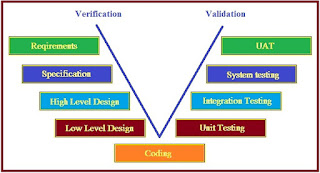Lecture No 2:
Hello All,
Q) What is SDLC (Software Development Life Cycle)
Software
Development Life Cycle:
The creation of a new software product may involve
dozens of team members and every one playing the different roles in tight
schedule.
SDLC is an standard process to develop the Software
Application. Software development life cycle has distinct phases which are
followed to develop the Software Application. Each phase performing the
different tasks.
There are two SDLC process:
i)
Sequential Model
ii)
Incremental Model
Most useful SDLC process in Software organization
are follows:
i)
Sequential Mode
a) Waterfall
Model
b) V-
Model
ii)
Incremental Model
c) Agile
Model(using Scrum)
d) Spiral
Model
Waterfall Model:
The waterfall model moves down a series of steps
starting from an initial idea to a final product. At the end of each phase, the
project team holds a ready to move to the next step.
If the project is not ready to progress for the next
phase, this time you can say that level is not ready.
Please check the Fig.
In waterfall model there is no way to back up. You need to complete the tasks for that step and
then move on .
V- Model:
Verification :
·
Verification is the process confirming
that something software meets its specification .
·
In verification, testers are looking for
the bug in non running elements of the software life cycle.
Ex.
Requirement documents, Design Documents, Coding etc..
·
Tester can ask one question: Are we
building the product right?
Validation :
·
Validation is the process to confirming
that it meets the user’s requirements.
·
In validation, testers are looking for
the bug in running state.
·
In this case testers running the
developed module and compare the behavior with requirement document.
·
Tester can ask one question: Are we
building the right product?
Agile
(using Scrum)
What
Is Agile?
Not a methodology! The Agile movement is
alternatives to traditional project management. Agile approaches help teams
respond to unpredictability through
incremental, iterative work. Agile propose
alternatives to waterfall, or traditional sequential development.
What
is Scrum?
Scrum is the most popular way of introducing Agile
due to its simplicity and flexibility. Because of this popularity, many
organizations are working on Scrum. In scrum team is self management, and
striving to build properly tested product increments within short iterations.
Scrum has only three roles: Product Owner, Team, and
Scrum Master. These are described in detail bellow.
Scrum has five meetings: Backlog Refinement meeting,
Sprint Planning, Daily Standup Scrum, the Sprint Review Meeting, and the Sprint
Retrospective Meeting.
Scrum
Roles
Scrum has three roles: Product
Owner, Scrum Master, and Team.
- Product Owner: The Product Owner should be a person with vision, authority, and availability. The Product Owner is responsible for continuously communicating the vision and priorities to the development team.
- Scrum Master: The Scrum Master acts as a facilitator for the Product Owner and the team. The Scrum Master does not manage the team. The Scrum Master works to remove any difficulties that are obstructing the team from achieving its sprint goals. This helps the team remain creative and productive while making sure its successes are visible to the Product Owner.
- Team: For a software projects, a team includes a mix of software engineers, architects, programmers, analysts, QA experts, testers, and UI designers. Each sprint, the team is responsible for determining how it will accomplish the work to be completed. The team has autonomy and responsibility to meet the goals of the sprint.
If you want to know more about Agile please feel free to post a comment I will defiantly write a special blog for Agile.
Thank you for Visit waiting for your comments, Bye.





